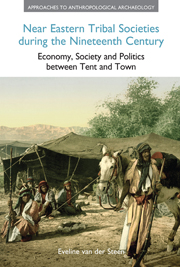 Near Eastern Tribal Societies during the Nineteenth Century
Near Eastern Tribal Societies during the Nineteenth Century “By God!” said he, “the plain is covered with places wherein I rested.” He had struck the note. I looked out beyond him into the night and saw the desert with his eyes, no longer empty but set thicker with human associations than any city. Every line of it took on significance, every stone was like the ghost of a hearth in which the warmth of Arab life was hardly cold, though the fire might have been extinguished this hundred years. It was a city of shadowy outlines visible one under the other, fleeting and changing, combining into new shapes elements that are as old as Time, the new indistinguishable from the old and the old from the new.
(Gertrude Bell, The Desert and the Sown, 1907)Introduction
Landscape: the geography, geology, climate and ecosystem of a region or country play a vital role in almost all aspects of society. Mountains and wadis define the land and give it structure and meaning for those who live in it. Natural resources such as water and fertile soil are vital for survival, and therefore a major cause of territorial conflict. Territorial rights and ownership of the land continually shaped and reshaped settlement patterns and power structures.
For Western travellers to the Near East, the landscape had a different meaning. Palestine and parts of Transjordan were the land of the Bible, and they saw the biblical stories of the Exodus, Joshua and the Judges re-enacted in the daily life of Bedouin and fellahin. The black tents of the Bedouin were like the tents of the Israelites, and the Shepherd King Mesha could be a shaykh of the Beni Sakhr or the Adwan. They identified biblical sites in the names of modern villages and ruins, either systematically, as Edward Robinson did, or simply as an erudite pastime in the manner of Burckhardt or de Saulcy. Their “biblical” outlook could influence their observations.
To save this book to your Kindle, first ensure [email protected] is added to your Approved Personal Document E-mail List under your Personal Document Settings on the Manage Your Content and Devices page of your Amazon account. Then enter the ‘name’ part of your Kindle email address below. Find out more about saving to your Kindle.
Note you can select to save to either the @free.kindle.com or @kindle.com variations. ‘@free.kindle.com’ emails are free but can only be saved to your device when it is connected to wi-fi. ‘@kindle.com’ emails can be delivered even when you are not connected to wi-fi, but note that service fees apply.
Find out more about the Kindle Personal Document Service.
To save content items to your account, please confirm that you agree to abide by our usage policies. If this is the first time you use this feature, you will be asked to authorise Cambridge Core to connect with your account. Find out more about saving content to Dropbox.
To save content items to your account, please confirm that you agree to abide by our usage policies. If this is the first time you use this feature, you will be asked to authorise Cambridge Core to connect with your account. Find out more about saving content to Google Drive.